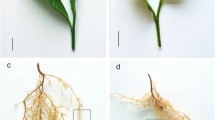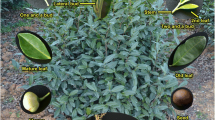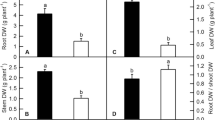Abstract
The effects of the different forms of N, ammonium (NH4+) and nitrate (NO3−), on secondary metabolite biosynthesis in tea plants are well known. However, the mechanisms of underlying these effects are not well understood. This study generated transcriptomic profiles of Camellia sinensis treated with different N forms for 5 min and 96 h using RNA-Seq. Analysis of differentially expressed genes (DEGs) showed that the regulated DEGs involved in the secondary pathways in the NH4+-treatment were more abundant than those in the NO3−- and NH4++NO3−-treatments, demonstrating the preference of tea plants for NH4+ at the gene level. Expression analysis at different treatment times showed that increasing treatment time changed not only the number of DEGs involved in secondary metabolism but also the pathways of secondary biosynthesis. In addition, only a few DEGs involved in secondary metabolism were regulated in more than one treatment. These results suggested that the secondary biosynthesis pathways regulated by N were dependent on the N form and treatment time. The analysis of DEGs related to transport and N metabolism further confirmed this conclusion. Moreover, the change of DEGs in NO3−-treated tea plants suggested increase of treatment time might attenuate the flavonoid biosynthesis and enhance the theanine and caffeine biosynthesis. The identification of differentially expressed transcription factors revealed the possible crosstalk between the secondary metabolic pathways in C. sinensis. These results help facilitate an understanding of the effects of N on tea quality and represent a valuable reference for the rational application of N fertiliser on tea plantations.








Similar content being viewed by others
References
Anders S, Huber W (2010) Differential expression analysis for sequence count data. Genome Biol 11:R106
Baudry A, Caboche M, Lepiniec L (2006) TT8 controls its own expression in a feedback regulation involving TTG1 and homologous MYB and bHLH factors, allowing a strong and cell-specific accumulation of flavonoids in Arabidopsis thaliana. Plant J 46:768–779
Chen Z, Chen L (2012) Delicious and healthy tea: an overview. In: Global tea breeding, advanced topics in science and technology in China. Zhejiang University and Heidelberg. Springer, Hangzhou, pp 1–1
de Mejia EG, Ramirez-Mares MV, Puangpraphant S (2009) Bioactive components of tea: cancer, inflammation and behavior. Brain Behav Immun 23:721–731
Dixon RA, Pasinetti GM (2010) Flavonoids and isoflavonoids: from plant biology to agriculture and neuroscience. Plant Physiol 154:453–457
Fan K, Fan D, Ding Z, Su Y, Wang X et al (2015) Cs-miR156 is involved in the nitrogen form regulation of catechins accumulation in tea plant (Camellia sinensis L.). Plant Physio Biochem 97:350–360
Fasseas MK, Tsikou D, Flemetakis E et al (2011) Molecular and biochemical analysis of the alpha class carbonic anhydrases in Caenorhabditis elegans. Mol Biol Rep 38:1777–1785
Grabherr MG, Haas BJ, Yassour M et al (2015) Global transcriptome and gene regulation network for secondary metabolite biosynthesis of tea plant (Camellia sinensis). BMC Genom 16:560
Hanke GT, Kimata-Ariga Y, Taniguchi I et al (2004) A post genomic characterization of arabidopsis ferredoxins. Plant Physiol 134:255–264
Hewavitharanage P, Karunaratne S, Kumar NS (1999) Effect of caffeine onshot-hole borer beetle (Xyleborus fornicatus) of tea (Camellia sinensis). Phytochemistry 51:35–41
Kamau DM, Spiertz JHJ, Oenema O, Owuor PO (2008) Productivity and nitrogen use of tea plantations in relation to age and genotype. Field Crops Res 108:60–70
Kanehisa M, Araki M, Goto S et al (2008) KEGG for linking genomes to life and the environment. Nucleic Acids Res 36:D480–D484
Leterrier M, Río L (2005) Peroxisomal monodehydroascorbate reductase. Genomic clone characterization and functional analysis under environmental stress conditions. Plant Physiol 138:2111–2123
Li B, Dewey C (2011) RSEM: accurate transcript quantification from RNA-Seq data with or without a reference genome. BMC Bioinform 12:323
Li N, Silva J De (2011) Theanine: its occurrence and metabolism in tea. Ann Plant Rev 42:171–206
Li CF, Zhu Y, Yu Y et al (2011) Full-length transcriptome assembly from RNA-Seq data without a reference genome. Nat Biotechnol 29:644–652
Li CF, Zhu Y, Yu Y et al (2015) Global transcriptome and gene regulation network for secondary metabolite biosynthesis of tea plant (Camellia sinensis). BMC Genom 16:560
Li ZX, Yang WJ, Jala G (2016) Developmental changes in carbon and nitrogen metabolism affect tea quality in different leaf position. Plant Physiol Biochem 106:327–335
Li W, Xiang F, Zhong M et al (2017) Transcriptome and metabolite analysis identifies nitrogen utilization genes in tea plant (Camellia sinensis). Sci Rep 7:1693
Livaka KJ, Schmittgen TD (2001) Analysis of relative gene expression data using real-time quantitative PCR. Methods 25:402–408
Mao X, Cai T, Olyarchuk JG, Wei L (2005) Automated genome annotation and pathway identification using the KEGG Orthology (KO) as a controlled vocabulary. Bioinformatics 21:3787–3793
Nesi N, Jond C, Debeaujon I et al (2001) The Arabidopsis TT2gene encodes an R2R3 MYB domain protein that acts as a key determinant for proanthocyanidin accumulation in developing seed. Plant Cell 13:2099–2114
Paul A, Jha A, Bhardwaj S et al (2014) RNA-seq-mediated transcriptome analysis of actively growing and winter dormant shoots identifies non-deciduous habit of evergreen tree tea during winters. Sci Rep 4:5932
Ruan J, Gerendás J, Härdter R, Sattelmacher B (2007a) Effect of nitrogen form and root-zone pH on growth and nitrogen uptake of Tea (Camellia sinensis) plants. Ann Bot 99:301–310
Ruan J, Gerendás J, Härdter R, Sattelmacher B (2007b) Effect of root zone pH and form and concentration of nitrogen on accumulation of quality-related components in green tea. J Sci Food Agric 87:1505–1516
Ruan L, Wei K, Wang L et al (2016) Characteristics of NH4 + and NO3 – fluxes in tea (Camellia sinensis) roots measured by scanning ion-selective electrode technique. Sci Rep 6:38370
Shi D, Winston JH, Blackburn MR et al (1997) Diverse genetic regulatory motifs required for murine adenosine deaminase gene expression in the placenta. J Biol Chem 272:2334–2341
Shi CY, Yang H, Wei CL et al (2011) Deep sequencing of the Camellia sinensis transcriptome revealed candidate genes for major metabolic pathways of tea-specific compounds. BMC Genom 12:131
Storey JD, Tibshirani R (2003) Statistical significance for genome wide studies. Proc Natl Acad Sci USA 100:9440–9445
Trapnell C, Williams BA, Pertea G et al (2010) Transcript assembly and quantification by RNA-Seq reveals unannotated transcripts and isoform switching during cell differentiation. Nat Biotechnol 28:511–515
Yamaguchi S, Ninomiya K (2000) Umami and food palatability. J Nutr 130:921–926
Yang YY, Li XH, Ratcliffe RG, Ruan JY (2013) Characterization of ammonium and nitrate uptake and assimilation in roots of tea plants (Camellia sinensis (L.) O. Kuntze). Russian J Plant Physiol 60:91–99
Young MD, Wakefield MJ, Smyth GK, Oshlack A (2010) Gene ontology analysis for RNA-seq: accounting for selection bias. Genome Biol 11:1–12
Acknowledgements
This work was supported by the National Key Research and Development Plan (2016YFD0200900), the National Natural Science Foundation of China (nos. 31400587, 31600558), the Chinese Academy of Agricultural Science through Agricultural Sciences Innovation Project (CAAS-ASTIP-2014-TRICAAS), the Jiangsu Agriculture Science and Technology Innovation Fund of China (CX(13)5016) and Jiangsu Natural Science Foundation (BK20160590).
Author information
Authors and Affiliations
Corresponding author
Additional information
Communicated by M. H. Walter.
Electronic supplementary material
Below is the link to the electronic supplementary material.
Rights and permissions
About this article
Cite this article
Yang, Y., Wang, F., Wan, Q. et al. Transcriptome analysis using RNA-Seq revealed the effects of nitrogen form on major secondary metabolite biosynthesis in tea (Camellia sinensis) plants. Acta Physiol Plant 40, 127 (2018). https://doi.org/10.1007/s11738-018-2701-0
Received:
Revised:
Accepted:
Published:
DOI: https://doi.org/10.1007/s11738-018-2701-0




